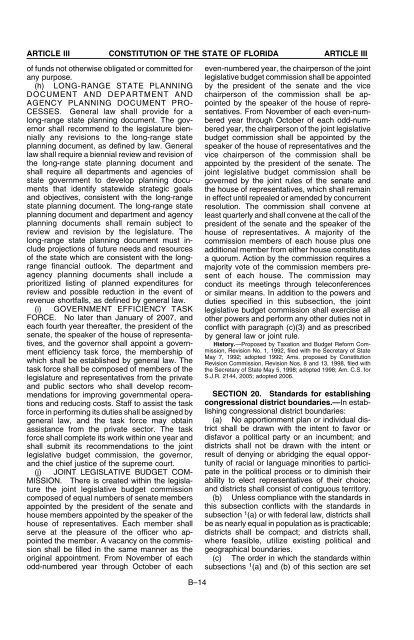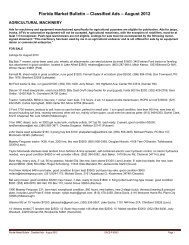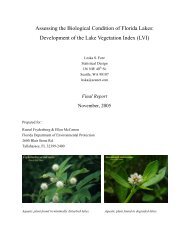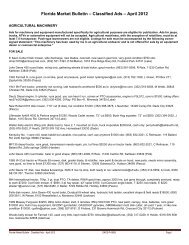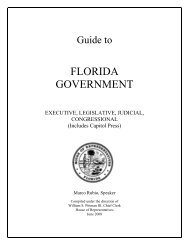Version A final setup - Florida House of Representatives
Version A final setup - Florida House of Representatives
Version A final setup - Florida House of Representatives
Create successful ePaper yourself
Turn your PDF publications into a flip-book with our unique Google optimized e-Paper software.
ARTICLE III CONSTITUTION OF THE STATE OF FLORIDA ARTICLE III<br />
<strong>of</strong> funds not otherwise obligated or committed for<br />
any purpose.<br />
(h) LONG-RANGE STATE PLANNING<br />
DOCUMENT AND DEPARTMENT AND<br />
AGENCY PLANNING DOCUMENT PRO-<br />
CESSES. General law shall provide for a<br />
long-range state planning document. The governor<br />
shall recommend to the legislature biennially<br />
any revisions to the long-range state<br />
planning document, as defined by law. General<br />
law shall require a biennial review and revision <strong>of</strong><br />
the long-range state planning document and<br />
shall require all departments and agencies <strong>of</strong><br />
state government to develop planning documents<br />
that identify statewide strategic goals<br />
and objectives, consistent with the long-range<br />
state planning document. The long-range state<br />
planning document and department and agency<br />
planning documents shall remain subject to<br />
review and revision by the legislature. The<br />
long-range state planning document must include<br />
projections <strong>of</strong> future needs and resources<br />
<strong>of</strong> the state which are consistent with the longrange<br />
financial outlook. The department and<br />
agency planning documents shall include a<br />
prioritized listing <strong>of</strong> planned expenditures for<br />
review and possible reduction in the event <strong>of</strong><br />
revenue shortfalls, as defined by general law.<br />
(i) GOVERNMENT EFFICIENCY TASK<br />
FORCE. No later than January <strong>of</strong> 2007, and<br />
each fourth year thereafter, the president <strong>of</strong> the<br />
senate, the speaker <strong>of</strong> the house <strong>of</strong> representatives,<br />
and the governor shall appoint a government<br />
efficiency task force, the membership <strong>of</strong><br />
which shall be established by general law. The<br />
task force shall be composed <strong>of</strong> members <strong>of</strong> the<br />
legislature and representatives from the private<br />
and public sectors who shall develop recommendations<br />
for improving governmental operations<br />
and reducing costs. Staff to assist the task<br />
force in performing its duties shall be assigned by<br />
general law, and the task force may obtain<br />
assistance from the private sector. The task<br />
force shall complete its work within one year and<br />
shall submit its recommendations to the joint<br />
legislative budget commission, the governor,<br />
and the chief justice <strong>of</strong> the supreme court.<br />
(j) JOINT LEGISLATIVE BUDGET COM-<br />
MISSION. There is created within the legislature<br />
the joint legislative budget commission<br />
composed <strong>of</strong> equal numbers <strong>of</strong> senate members<br />
appointed by the president <strong>of</strong> the senate and<br />
house members appointed by the speaker <strong>of</strong> the<br />
house <strong>of</strong> representatives. Each member shall<br />
serve at the pleasure <strong>of</strong> the <strong>of</strong>ficer who appointed<br />
the member. A vacancy on the commission<br />
shall be filled in the same manner as the<br />
original appointment. From November <strong>of</strong> each<br />
odd-numbered year through October <strong>of</strong> each<br />
B–14<br />
even-numbered year, the chairperson <strong>of</strong> the joint<br />
legislative budget commission shall be appointed<br />
by the president <strong>of</strong> the senate and the vice<br />
chairperson <strong>of</strong> the commission shall be appointed<br />
by the speaker <strong>of</strong> the house <strong>of</strong> representatives.<br />
From November <strong>of</strong> each even-numbered<br />
year through October <strong>of</strong> each odd-numbered<br />
year, the chairperson <strong>of</strong> the joint legislative<br />
budget commission shall be appointed by the<br />
speaker <strong>of</strong> the house <strong>of</strong> representatives and the<br />
vice chairperson <strong>of</strong> the commission shall be<br />
appointed by the president <strong>of</strong> the senate. The<br />
joint legislative budget commission shall be<br />
governed by the joint rules <strong>of</strong> the senate and<br />
the house <strong>of</strong> representatives, which shall remain<br />
in effect until repealed or amended by concurrent<br />
resolution. The commission shall convene at<br />
least quarterly and shall convene at the call <strong>of</strong> the<br />
president <strong>of</strong> the senate and the speaker <strong>of</strong> the<br />
house <strong>of</strong> representatives. A majority <strong>of</strong> the<br />
commission members <strong>of</strong> each house plus one<br />
additional member from either house constitutes<br />
a quorum. Action by the commission requires a<br />
majority vote <strong>of</strong> the commission members present<br />
<strong>of</strong> each house. The commission may<br />
conduct its meetings through teleconferences<br />
or similar means. In addition to the powers and<br />
duties specified in this subsection, the joint<br />
legislative budget commission shall exercise all<br />
other powers and perform any other duties not in<br />
conflict with paragraph (c)(3) and as prescribed<br />
by general law or joint rule.<br />
History.—Proposed by Taxation and Budget Reform Commission,<br />
Revision No. 1, 1992, filed with the Secretary <strong>of</strong> State<br />
May 7, 1992; adopted 1992; Ams. proposed by Constitution<br />
Revision Commission, Revision Nos. 8 and 13, 1998, filed with<br />
the Secretary <strong>of</strong> State May 5, 1998; adopted 1998; Am. C.S. for<br />
S.J.R. 2144, 2005; adopted 2006.<br />
SECTION 20. Standards for establishing<br />
congressional district boundaries.—In establishing<br />
congressional district boundaries:<br />
(a) No apportionment plan or individual district<br />
shall be drawn with the intent to favor or<br />
disfavor a political party or an incumbent; and<br />
districts shall not be drawn with the intent or<br />
result <strong>of</strong> denying or abridging the equal opportunity<br />
<strong>of</strong> racial or language minorities to participate<br />
in the political process or to diminish their<br />
ability to elect representatives <strong>of</strong> their choice;<br />
and districts shall consist <strong>of</strong> contiguous territory.<br />
(b) Unless compliance with the standards in<br />
this subsection conflicts with the standards in<br />
subsection 1 (a) or with federal law, districts shall<br />
be as nearly equal in population as is practicable;<br />
districts shall be compact; and districts shall,<br />
where feasible, utilize existing political and<br />
geographical boundaries.<br />
(c) The order in which the standards within<br />
subsections 1 (a) and (b) <strong>of</strong> this section are set


